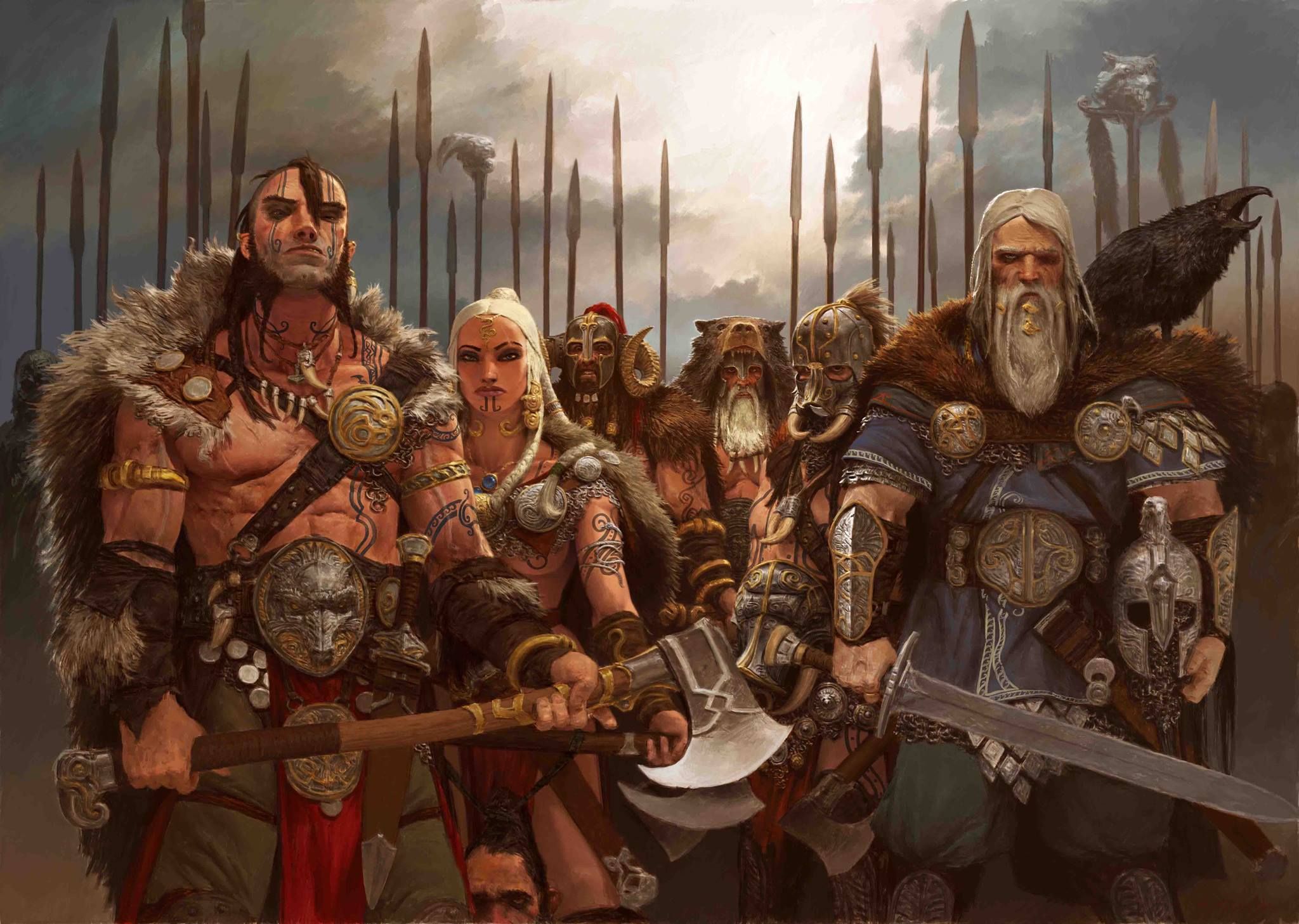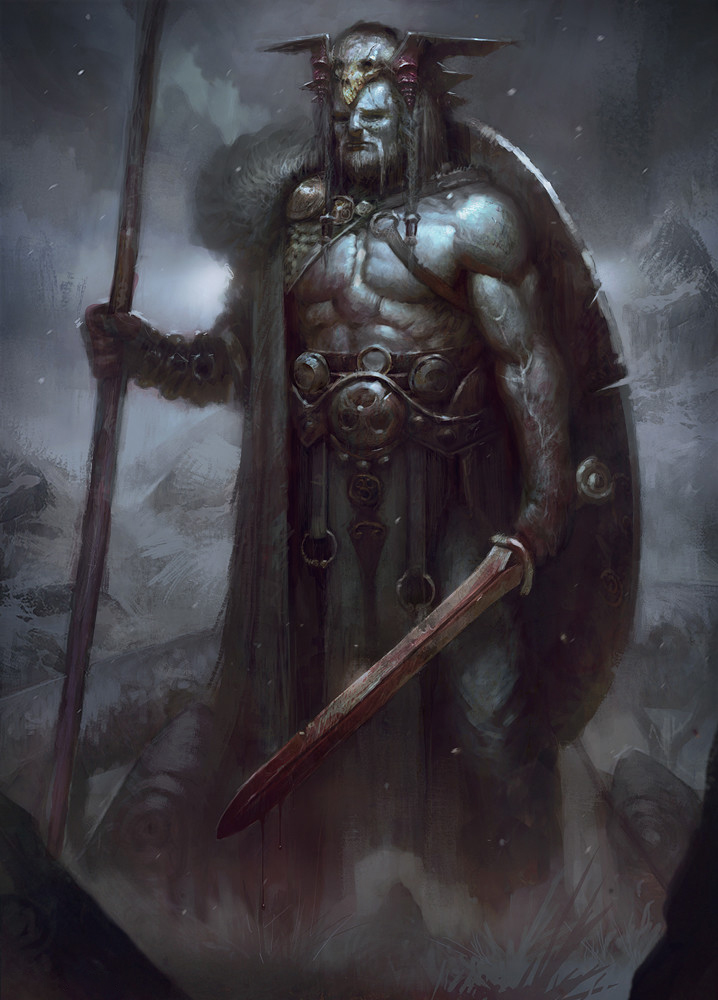Tribes & Clans of Cor Danath
Across the moon-bathed highlands and wind-swept moors of Cor Danath lives a deceptively large amount of disparate clans and tribes of differing races united only in their complete disregard for tenets of what most other nations of Dol Teroth would consider to be "civilized".
Though their homeland is hostile and unforgiving, they find not only need but also great pleasure in war, battle and raiding. So much so, that many of them have completely centred their cultures around the propagation and pursuit of battle and warrior lifestyle. They value strength and endurance as much as cunning and resourcefulness, and believe that to survive in Cor Danath, one needs to be ready to kill or be killed from an early age. Therefore, it is not uncommon to see war-bands of Cor Danath's various groups being comprised of men and women, the elderly and children alike.
They came at us with pikes and axes and bludgeons. They came at us from all sides, charging down the craggy hills and howling like rabid dogs. These unwashed clansmen assailed the armoured column, again and again, falling upon their shields and swords only to retreat and strike again, with blood lust in their eyes and frothing at their mouths. Our caravaneers fell one by one from their harrying, and I count myself lucky not to have donated my skull to one of their totem-poles, or worse.
Culture
Major language groups and dialects
The major language among the tribes and clans is some form of vernacular known as Danathian, with trace lingual differences, and disparate accents. Those of different racial descendence still speak traces of their original racial languages in addition to the main dialect of their tribe or clan.
Uncommon secondary languages among those better-educated highlanders and moorsmen are Aphtonian, Mielian, and Hygge.
Shared customary codes and values
Various tribes and clans of Cor Danath revel in battle and raiding. They value strength, endurance, and skill in battle and consider those to be the foremost qualities of all men and women. There is infamy associated with such skills, with reputation preceding famous warriors wherever they go. To slay such a warrior by dishonourable means is grounds for a blood feud, although there are no strict tenets that ascribe what is or isn't considered dishonourable - though general consensus agrees on at least ambush and poison.
They respect the elderly in a macabre way, viewing those that have gone past their fighting age as "dead-to-be". They ascribe the same respect to such persons as they would a corpse, some even going so far as to say similar prayers when passing by an old person. In a comparable manner, the sick or sickly are viewed as just as weak, and often treated the same as those old people unable to fight any more, while more egregious cases even result in exile or murder.
Common Etiquette rules
As warlike people, it is expected for one to speak of their warrior heritage and deeds of their famous ancestors, then follow those with tales of their own victories. A showing of great mementoes, totems and weaponry are looked upon favourably, and the whole clan or tribe judges the individual for their merits. If they are found wanting, they would find themselves without hospitality at best.
It is also customary to present the chieftain, tywysog, warlord, etc, with riches or gifts that they would deem fitting of their stature and warrior prowess, and their spouse (or parent, if unwed) with a fitting household gift. Those would be appraised, and if approved, one could expect full hospitality of the clan or tribe, and full protection under the law of the ruler, often represented by some customary gift or deed.
Coming of Age Rites
Almost all clans and tribes have some form of ritual when a promising youngster comes of age. With almost every one of them calling it differently, the western scholars have nicknamed the disparate similar practices "the quickening". Most commonly, the youth is given a sharpened piece of flint and sent out, away from the tribe. They wear special clothes that their mothers knit for them over their formative years, that inform of their parentage, clan, and heritage.
They are expected to return with one of three (and in more ruthless clans, all three): a stolen spouse, a corpse of a mighty beast, the corpse of a warrior from a rival clan (though some clans allow for a captive). The night of their return, they are expected to commit their future to the clan or tribe by bedding their spouse to create offspring; eating the heart, liver, and brain of the beast; using a significant piece of the warrior's corpse to create a memento or totem that they would wear on them forever. Failing in any part of their quest leads to banishment (often posthumously, because they would presumably be already dead), while success inducts them among the full-fledged adults of their community.
Funerary and Memorial customs
With the ground of Cor Danath often being too hard or shallow to dig graves, and value of trees being too high for regular pyres, people of the region have taken to two different forms of corpse disposal. In southern and eastern parts, where bogs and moors are commonly found, corpses are most often subject to bog burials, submerged and given back to the murky liquid and slime. Meanwhile, in the northern and western craggy highland parts of the region, corpses are given sky funerals, left for the elements and scavengers to take them to their afterlife. Each tribe or clan practices their own particular brand of memorial service, as well as their own reverence for the dead, both of which outsiders rarely witness.
Related Locations
Remove these ads. Join the Worldbuilders Guild












Comments